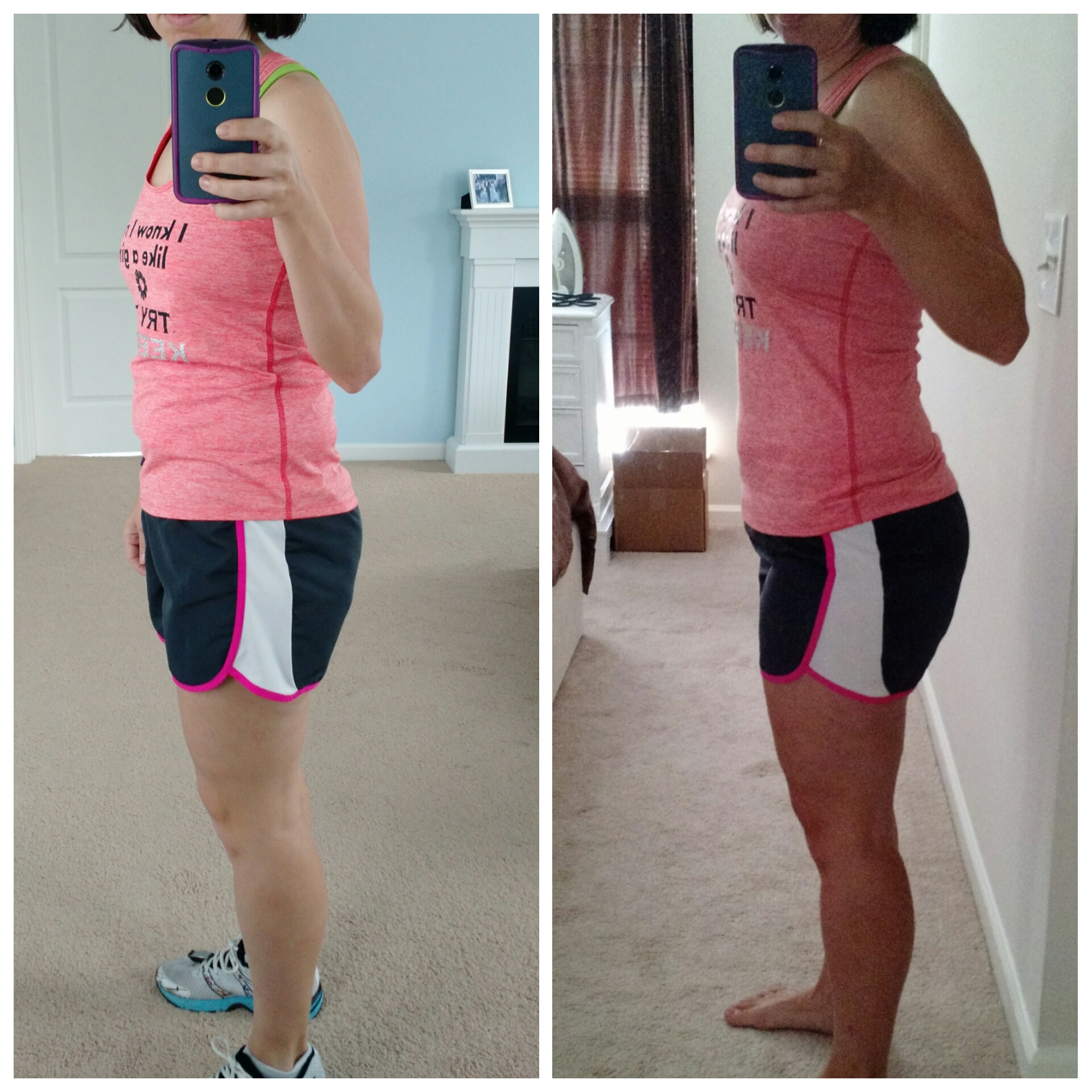
by | Aug 3, 2016 | Building Muscle, Metabolism Reset, The Journey
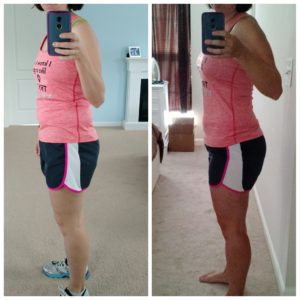 I’ve followed the EM2WL method for a few years (with great success!), and then last autumn, race season got a little crazy because I signed up for 2 half marathons. I enjoy running for the sanity-saving benefits (I have 4 kids ages 3-6!) but I LOVE lifting because I love being strong! Since I promised some friends I would run in the half-marathons, though, lifting had to take a backseat while I trained for those races. I was eating “enough” but noticing fat gain/muscle loss and started reducing my calories to try to tweak things. Obviously that was not the thing to do, as my body composition started getting worse and worse, despite eating fewer calories. I never NETTED below 1700 but with how much running I was doing, I still needed more, plus I needed to add lifting back in. (I wish I could go back in time to August 2015 when I started the crazy lowering-lowering-lowering of calories to tell myself to start increasing instead!! But lesson learned.)
I’ve followed the EM2WL method for a few years (with great success!), and then last autumn, race season got a little crazy because I signed up for 2 half marathons. I enjoy running for the sanity-saving benefits (I have 4 kids ages 3-6!) but I LOVE lifting because I love being strong! Since I promised some friends I would run in the half-marathons, though, lifting had to take a backseat while I trained for those races. I was eating “enough” but noticing fat gain/muscle loss and started reducing my calories to try to tweak things. Obviously that was not the thing to do, as my body composition started getting worse and worse, despite eating fewer calories. I never NETTED below 1700 but with how much running I was doing, I still needed more, plus I needed to add lifting back in. (I wish I could go back in time to August 2015 when I started the crazy lowering-lowering-lowering of calories to tell myself to start increasing instead!! But lesson learned.)
Finally, this past January, I complained to my husband about how I couldn’t seem to lose the fat despite decreasing my calories and he asked “do you think you might need a reset? Are you eating enough?” and the light bulb went off. He stated that I can never claim he ‘doesn’t listen to me’ because he remembered my talking about EM2WL and metabolism resets and such a couple years ago! Haha! So at the beginning of February, I started increasing my calories to reach maintenance (2100-2200 based on my Fitbit Charge HR, plus more if I ran). I took pictures of myself before I started my calorie increase (photos on left in comparison shots).
My second half marathon was scheduled for the beginning of April, but I downgraded it to the 5k option because I really wanted to focus on regaining my lost muscle and not worrying about running.
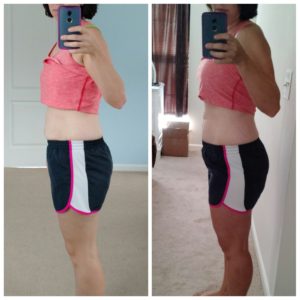 BEST. DECISION. EVER.
BEST. DECISION. EVER.
I completed a 9 week reset and started a cut at 1900, which I quickly increased to 2000 due to lack of energy during lifts. I had already gained 10 pounds “at a deficit” while training last year that never came off, and then I gained 14-16 pounds during my reset. I started my cut and haven’t lost anything yet, but that’s okay because I’m still making gains in the lifts and that’s what I was mainly focused on. My lowest weight was 132 and I really loved my physique at that weight because I reached it combining running and heavy lifting (calories during cut were around 1800, so definitely following the EM2WL mentality!). Eventually I hope some of the fat will come back off since I’m currently hovering around 156-158 pounds (I’m 5’5.5”). My TDEE has also increased due to my increased weight, I suppose, so now I average 2300 without running based on my Fitbit.
This afternoon I squeezed into the clothes I was wearing when I started my reset, and those are the (tan!) pics on the right. The clothes are definitely tight, but I love how I actually have a better overall SHAPE than I did before! In a week, I’ll be starting a much-anticipated 2-week diet break. My lifting throughout February-April was starting over with StrongLifts 5×5 (since I’d lost most of my strength from running). I’m living in an apartment for about 6 months and don’t have access to my barbell but I did 3 weeks of NRoL Fat Loss 1, and am currently doing your heavy/light dumbbell workout at our apartment gym. Anyway, I just thought I’d share my in-progress story with you!
~mrs_dwr on MFP

by EM2WL | Feb 18, 2016 | Building Muscle, LIVE Broadcasts, Metabolism Reset
If you’ve dieted in the past or are currently dieting, you may have experienced (or heard recently about) metabolic issues. Headlines, infomercials, and even your fave fitspo are doling out method after method for how to “fix” the damage done to your metabolism. We hunt for the best foods, drinks, supplements, workouts, and “bulletproof” ways to turn back the hands of time (dang you, aging process!!). Some are in denial, others using it as a crutch – but we can’t deny that our metabolisms seem to be doing everything in their power to work against us.
But what if the one aspect that we often glaze over/assume is negotiable when seeking to rebuild our metabolisms, is key to pulling this whole thing off? And where the heck does dieting (and finally losing that weight) come in to play?
When you’re dieting, the amount of calories you burn literally becomes less – anywhere from 300 (average) to 800 calories fewer. This change can happen in as little as a two month time frame because of what dieting does to our metabolism. This adaptation, in addition to the natural aging process of the body that also slows the metabolism, can create the perfect backdrop for what is now trending as “metabolic damage.”
The effects of short bouts of dieting can affect your body for up to a year. Longer/repeated bouts can make this unwanted adaptation last even longer! The approach of eating less and working out more has a failure rate of 95%. For a generation that has more diet plans, health food stores, gyms (and internet access to pics of the fittest people on the planet) than ever before, the obesity epidemic is only rising. And it’s not for lack of trying…or at least not in full.
 Sedentary lifestyles (thanks again, technology!), of course, contributes heavily to slowed metabolic rates. Hormones also affect metabolism, as do environmental pollutants. Out of all these things, though, your muscles relationship to your metabolism carries the highest weight (literally). Most diets place primary focus (and success rating) on the amount of weight loss. However, twenty to fifty percent of the loss you experience during a typical, low-calorie/high cardio diet is muscle mass. Seventy-five percent of your BMR (basal metabolic rate) — the amount of calories you burn just being alive — is composed of your muscle. Therefore the more muscle you have, the higher your BMR becomes. And vice versa.
Sedentary lifestyles (thanks again, technology!), of course, contributes heavily to slowed metabolic rates. Hormones also affect metabolism, as do environmental pollutants. Out of all these things, though, your muscles relationship to your metabolism carries the highest weight (literally). Most diets place primary focus (and success rating) on the amount of weight loss. However, twenty to fifty percent of the loss you experience during a typical, low-calorie/high cardio diet is muscle mass. Seventy-five percent of your BMR (basal metabolic rate) — the amount of calories you burn just being alive — is composed of your muscle. Therefore the more muscle you have, the higher your BMR becomes. And vice versa.
This is important to understand in the scheme of weight loss. Striving to lose only weight – while paying little attention to where the weight comes from – is destructive to the maintenance of any perceived success. And if you’ve ever lost and regained weight before, you know that keeping the weight off is harder than getting it off in the first place. The second you go back to eating “normal,” game over.
So while you may end up weighing less after any given diet, it will be to the detriment of your metabolism. Those who simply lose weight from dieting, require less calories to maintain that weight than someone (of the same weight) who has never dieted. The more times you repeat this process, the lower your calorie requirements are. It’s a nasty metabolic game that you don’t want to play, and will likely never win.
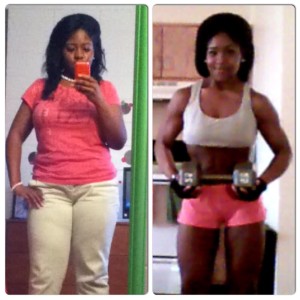
Kashonna focused on building muscle, and no longer worries about the scale!
Regardless of whether or not you want a muscular look, they key is the look that you want (less fat), without having to reduce calories into oblivion, requires muscle. The point of resistance training is to preserve the muscle mass you have and build more. If your muscle mass is decreasing due to the diet you’re on, then your plan of attack is counterproductive. Set your diet/exercise plan up for success. Dieting with no exercise will result in the highest loss of muscle. If you’re dieting with some cardio, you will lose slightly less muscle. If you’re dieting and doing resistance training, you will lose little to no muscle – this is key!
The bottom line? The best way to fix your metabolism is to build and rebuild muscle mass, not just lose fat (or worse, lose weight). Having more muscle will increase the amount of calories that your body requires, and will aid you in finally losing the fat. If you’ve already played Metabolic Roulette for longer than you can remember, then the steps to healing your metabolism will eventually become inevitable. Eat and exercise in a way that keeps or adds to the muscle mass you already have and you’ll be heading in the right direction to fix and maintain your metabolism at its highest efficiency.

by | Aug 11, 2015 | Consistency, Metabolism Reset, Strength Training, Testimonials, The Journey
I started my journey almost 2 years ago with a metabolism reset. I’ll try to be as brief as possible with my past, I went to a diet center and did a VERY low calorie (500/day along with taking 3, yes three, diet pills a day) high protein diet for approx. 8 months. When I reached my goal weight, I couldn’t afford to continue to pay for the maintenance portion of the diet, so 1.5 yrs later I gained it all back and then some. Then, I started a very low calorie diet (on my own) and it took me 1.5 yrs to lose 20 lbs. I was frustrated. My hair was thinning, I was grouchy all the time, couldn’t sleep, my fingernails were paper thin. I was working myself to death and I wasn’t losing weight or inches. That’s when I found EM2WL group on MFP. As I started reading the stickies, it was like I was reading my autobiography! I attempted to do a reset…however, patience (or lack thereof) became an issue and I gave up and went back to a 1200/cal/day diet. After seeing no change yet again…I bit the bullet and seriously did a reset. The only thing I would change about that, is the way I upped my calories. I jumped in gung ho and immediately gained 19 lbs in 2.5 mos time. That was very upsetting to me, but I kept at it. After following Anitra, Lucia and Kiki, I “found” Cathe Friedrich, and I was hooked on lifting!
afford to continue to pay for the maintenance portion of the diet, so 1.5 yrs later I gained it all back and then some. Then, I started a very low calorie diet (on my own) and it took me 1.5 yrs to lose 20 lbs. I was frustrated. My hair was thinning, I was grouchy all the time, couldn’t sleep, my fingernails were paper thin. I was working myself to death and I wasn’t losing weight or inches. That’s when I found EM2WL group on MFP. As I started reading the stickies, it was like I was reading my autobiography! I attempted to do a reset…however, patience (or lack thereof) became an issue and I gave up and went back to a 1200/cal/day diet. After seeing no change yet again…I bit the bullet and seriously did a reset. The only thing I would change about that, is the way I upped my calories. I jumped in gung ho and immediately gained 19 lbs in 2.5 mos time. That was very upsetting to me, but I kept at it. After following Anitra, Lucia and Kiki, I “found” Cathe Friedrich, and I was hooked on lifting!
 On New Year’s Eve, my husband, myself and our boys were invited to join friends on a vacation to the Florida Keys. That was the incentive I needed to get real with my diet and exercise. I started my cut on 1/1/15 and did Cathe’s Muscle Max for 6 weeks. Not long after I started Muscle Max, I purchased the EM2WL Beginner Strength Training Program e-book and it was one of the best purchases I’ve made! I timed it so that I would finish the program about 2 weeks before we were to leave for vacation. Giving myself a cushion for “life” to happen and possibly delay me. I finished 1.5 weeks before we left.
On New Year’s Eve, my husband, myself and our boys were invited to join friends on a vacation to the Florida Keys. That was the incentive I needed to get real with my diet and exercise. I started my cut on 1/1/15 and did Cathe’s Muscle Max for 6 weeks. Not long after I started Muscle Max, I purchased the EM2WL Beginner Strength Training Program e-book and it was one of the best purchases I’ve made! I timed it so that I would finish the program about 2 weeks before we were to leave for vacation. Giving myself a cushion for “life” to happen and possibly delay me. I finished 1.5 weeks before we left.
On the surface, I only lost 11 lbs and 10.5 inches. I say “only” because the REAL change was internal/emotional/mental. Now, don’t get me wrong, I’m VERY pleased with my results so far! The biggest “gain” I’ve made is mentally. I’ve learned patience, patience, patience! I knew going into this that the scale is a big fat liar when you are doing this the EM2WL way. I weighed myself just out of curiosity, not expecting to see dramatic changes in the numbers. Because when you lift heavy, you retain water, which results in the scale going in the wrong direction. Take it from me…the scale is irrelevant!
The feeling I got from lifting and the gains I made with my strength, are priceless. It’s hard to explain the mental gains I’ve made. The best way I can describe it is I realized this change was happening from the inside out. I came of the mindset that people can’t see the changes from the outside….that comes closer to the end. I have a confidence that I’ve never had before. You can’t see it by looking straight at me, but when I look down from my shoulder down my arms, there’s cut/definition!!! I see my legs starting to take on a shape that I’ve only dreamed about.
There’s no doubt in my mind that had I not conditioned myself the way I did, I would NEVER have been able to reel the fish in, balance myself, and endure a minimum of 8 hrs offshore fishing on our vacation. Let me tell you, those fish put up a fight! 
Before we left, I tried on a bathing suit that I’ve had for years…and it didn’t fit right. I was devastated! I turned to Anitra to “talk me off the ledge” of complete devastation. Anitra told me that I shouldn’t judge/base my progress on old clothes. She said that my body is taking on new shape, and clothes that used to fit (smaller ones) probably won’t fit again regardless of the size. She told me not to get discouraged, this is a part of the process. She told me to go out and find something that I’m comfortable in now, that’s the important thing. So, I decided to wear bike shorts and a sports bra under a tank top!
Now, I’m back from vacation and moving on to the next phase of my lifting. I’m going to do Cathe’s Gym Style Series for 6 weeks and then her Slow and Heavy for a few weeks preparing myself for the STS Series on October 1st. All of my workouts have been done at home. No gym membership. It’s nothing fancy, by any means, but it’s mine!
People, this lifestyle is so very, very doable! I’ve made this progress eating between 1900-2200 calories a day! This is the best/smartest way to live your life. I’m never starving, like I was the whole time I was doing the low cal thing. If I want slice of cake, bowl of ice cream, a glass of wine…I have it! Everything in moderation. If you slip up, no worries…just get right back at it the next day! Every day is a new day! I am nowhere close to the end of this journey. My changes are 98% mental, and that doesn’t show in a picture. I have so much to learn and I’m beyond excited to see what the future holds for me! I can promise this…it will forever involve Eating More 2 Weigh Less!!!

Look at the changes through her mid-section! And this after increasing her intake from 1,200 to 1,900 – 2,200 calories a day and implementing strength training!

by EM2WL | Jun 23, 2015 | Fat Loss / Cutting, Interviews/Guest Posts, Metabolism Reset
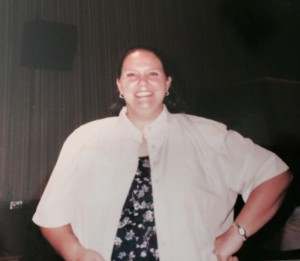 When did you first learn that you needed to eat more to reach your goals? What was your original response?
When did you first learn that you needed to eat more to reach your goals? What was your original response?
After hitting my weight loss goal with Weight Watchers in 2012, I was working out on average an hour per day, almost every single day, and feeling extremely hungry all the time. I felt like I was having to white-knuckle my eating in accordance with my exercise.
I couldn’t figure out why it was such a struggle to maintain my body weight. I started doing some research and found that, on average, I was eating around 1900 calories a day, maybe 2000 when you averaged it out over the week. I stumbled across “Eat More to Weigh Less” and some other blogs promoting the idea of eating according to your TDEE and activity level and I felt like a light bulb had gone off. I had been far under-eating for my activity level. I purchased a Body Media Band at the time and was astonished to realize that on certain days I was burning 2,600 to 2,700 calories a day, because of all my activities. I realized at that point that I was just not well-informed on how much calories my body required in order to maintain my weight. My dietary habits were based on a point system that wasn’t working for me anymore. Of course, my next response after this realization was thinking, “Yay! I get to eat more food.”
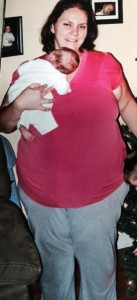 How did your body and scale in clothes, etc, react to the initial increase in calories?
How did your body and scale in clothes, etc, react to the initial increase in calories?
I felt a little bit bloated around my midsection, and I did see an initial creep up in weight on the scale. I was maintaining my weight between 150 and 152 pounds. I noticed my weight would hit, at most, 158 pounds, but ultimately I just felt a bit more puffy from all the extra food I was eating.
The last time I spoke with you (Kiki and Lucia), I had just started my cut at 2,100 calories with a 500 calorie deficit.
Has your calorie intake changed over the past two years, and if so, how?
My calories really haven’t changed much. I’ve been tracking them as of late because I’m currently cutting again. What I have noticed is that they typically fall between 2,300 and 2,600 per day, depending on my activity level. In the last two years, for the most part, I’ve kind of stayed within the same activity range and thus the same calorie range. I would say that, over all, I think most people (especially fairly active people) are probably unaware of how much they are burning in a day. I know I was really shocked when I learned about my own caloric levels.
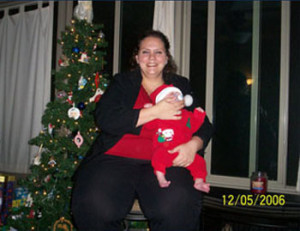 Have your fitness and health goals changed? For example, do you still monitor aim or maintain scale weight, or has your focus shifted more to performance or other goals?
Have your fitness and health goals changed? For example, do you still monitor aim or maintain scale weight, or has your focus shifted more to performance or other goals?
I actually do both. I am working on gaining strength. I’ve increased my squats, dead-lifts, bench presses. I’ve been focusing on all that, but I also keep an eye on the scale for myself. Having battled my weight my entire life, I’m not completely comfortable not checking on it. I created what I felt was a realistic weight range for me, 150 – 160 pounds. However, I’m more focused on gaining strength and building muscle and less on just losing weight. As long as I honor my commitment to myself by not gaining back the weight I lost initially, I’m fine.
 What has been the biggest revelation you’ve had since increasing your calories and lifting heavy weights?
What has been the biggest revelation you’ve had since increasing your calories and lifting heavy weights?
That it all balances out. Your weight training really impacts your metabolism. I never understood this. It shocks me how much I can eat and still be able to maintain my scale weight, and it’s because I lift weights. I feel completely different on the days I lift versus the days I don’t. My hunger levels are different. The foods I can eat are different. I’ve learned I can eat a heck of a lot more and still lose weight. That’s because I have a healthy metabolism now. And I attribute this change to taking the time to learn how to better feed my body in relation to my activity level from wonderful sites like Eat More to Weigh Less and others.
What method device do you use to determine your caloric intake? If you do use a Body Media or Fitbit, do you find it to be fairly accurate in terms of how much you are able to eat?
Yes, I use a Fitbit right now; although, I’ve used a Body Media Band in the past. Both devices typically show my caloric intake around the same place, which is anywhere from 2,200 calories all the way up to 2,700 calories per day. Most of these devices do not take into consideration things like weight training. However, they do capture my overall activity level and I have found them to be fairly accurate. If I were to take a cut in my calories using my Fit Bit as a guide, I’d find I don’t have to go to an extremely low calorie range to start losing weight.
If I gain enough weight to put me out of my personal weight range and I need to cut back, I typically focus on removing 500 calories from my daily intake. If I find that my average calorie burn is 2,400 during an average 7-day cycle, I know that if I eat around 1,900 calories, I will be able to lose weight. When I do this I’ll typically lose about a pound per week. However, many people think 1,900 calories is what they need to maintain their weight. Understanding what I actually need to maintain my weight versus lose weight was extremely eye-opening for me.
Now that you’re in maintenance, how do you stay motivated each and every day?
I stay motivated because I typically share a lot of what I learn with other people. I’m here to help inspire, motivate women to not only lose this weight, but to find a way that they can keep it off forever. I also find that it’s really not as difficult as I thought it was. When I was white-knuckling it at the beginning, it was extremely difficult because I was hungry all the time. Now that I know how much I can eat and I found an activity I really enjoy, it’s really not as painful as I once thought it would have been. Overall, I guess I have found something that I can do for the rest of my life. I found that I can eat this way for the rest of my life, enough it makes maintenance really not as difficult as I once thought it would be.
 Any parting words of encouragement for those who are new to eating more, struggling with the decisions to fuel properly?
Any parting words of encouragement for those who are new to eating more, struggling with the decisions to fuel properly?
If you’re maintaining your weight on a very low amount of calories, I highly recommend you take the gamble and do a reverse diet or metabolism reset. I always ask myself the question, “Can you continue to do what you’re doing for the rest of your life?” If I had to eat at 1,900 calories for the rest of my life, always feeling hungry, I don’t think I would have been able to maintain my weight loss.
So, if you were dieting down and eating 1,500 calories a day, and now you have to eat that amount of calories just to maintain your weight because your body has gotten used to it, I ask you, what other choice do you have? Well, you have two choices, actually. One, live with eating 1,500 calories for the rest of your life and be perpetually hungry. Or do a slow metabolism reset, where you increase your calories over time, and begin to let your metabolism repair itself from all the prolonged dieting you’ve done. Yes, you may gain a few pounds. My weight went up about 8 pounds total. 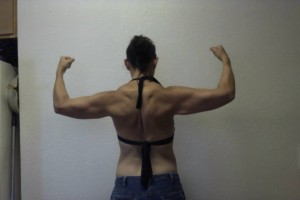 However, I can honestly say it’s the best 8 pounds I’ve ever gained! It was a great experiment for me to learn what my body needed and how I could feed it more fuel so I could enjoy my life more. There’s no point in dieting down just to be miserable for the rest of your life. Find a way that you can eat and move that you love and that is sustainable for you for the rest of your life.
However, I can honestly say it’s the best 8 pounds I’ve ever gained! It was a great experiment for me to learn what my body needed and how I could feed it more fuel so I could enjoy my life more. There’s no point in dieting down just to be miserable for the rest of your life. Find a way that you can eat and move that you love and that is sustainable for you for the rest of your life.
You can find out more about me and all the different things I have going on at HalfSizeMe.com. And be sure to check out my podcast, The Half Size Me Show, which is available in iTunes and Stitcher radio. I also have a Facebook page where I post videos and other content to help people. I’d love to connect with you on any social media platform.
Website: http://www.halfsizeme.com/
Podcast: http://www.halfsizeme.com/category/podcast/
Facebook: https://www.facebook.com/HalfSizeMe
 After spending most of her life since childhood overweight or morbidly obese, Heather Robertson finally resolved to lose the weight. It took five years, during which time she had three c-section pregnancies and a double-hernia operation, but she managed to lose 170 pounds. Over the past three years since reaching her goal weight, she’s learned the importance of developing a maintenance mindset.
After spending most of her life since childhood overweight or morbidly obese, Heather Robertson finally resolved to lose the weight. It took five years, during which time she had three c-section pregnancies and a double-hernia operation, but she managed to lose 170 pounds. Over the past three years since reaching her goal weight, she’s learned the importance of developing a maintenance mindset.
She founded the Half Size Me Community with her husband, who also produces her popular podcast, The Half Size Me Show, which was recently listed on The Huffington Post as being one of the 19 Best Health/Fitness Podcasts.
Heather’s driven to teach others how to live healthier, happier lives. She does this by hosting her podcast, working with the Half Size Me Community, and as a Life Coach who specializes in weight loss, habit change, and self-acceptance.

by | Apr 23, 2015 | Increasing calories, Metabolism Reset, Testimonials, The Journey
I’ve always been on a diet. I’m sure that’s not quite the case but I can’t remember NOT thinking about food in terms of “fat vs skinny” and “bad vs good.” When I was probably around 10 my mom and I went on The Beet and Ice Cream Diet. Yes, it’s exactly what it sounds like. For the record, it has taken about 25 years for me to eat another beet… I also recall that around this time I was actually being paid to lose weight, and I was absolutely thrilled when I got the flu. All this before the age of 12, and that set me up nicely for high school years marked by food anxiety, laxative abuse, binging and purging, cardio sessions that were literally hours long at a time, and most significantly, an extended bout with anorexia in which at the last weigh-in I remember I was 102 on my 5’9’’ frame. (I definitely want to say that eating disorders are never about food per se – there are underlying issues generally centering around feelings of control – but a childhood fraught with food anxieties can create an environment quite conducive to using eating disorders as an outlet for working through those issues.)
taken about 25 years for me to eat another beet… I also recall that around this time I was actually being paid to lose weight, and I was absolutely thrilled when I got the flu. All this before the age of 12, and that set me up nicely for high school years marked by food anxiety, laxative abuse, binging and purging, cardio sessions that were literally hours long at a time, and most significantly, an extended bout with anorexia in which at the last weigh-in I remember I was 102 on my 5’9’’ frame. (I definitely want to say that eating disorders are never about food per se – there are underlying issues generally centering around feelings of control – but a childhood fraught with food anxieties can create an environment quite conducive to using eating disorders as an outlet for working through those issues.)
Fast forward a bit and I finally had a relatively normal relationship with food. I was a healthy weight (about 135 – 145, I never owned a scale) and ate like a “normal” person: I ate when I was hungry, I ate healthily but indulged when I wanted, and I ran and did yoga when time permitted because it felt good to move. I felt I looked ok but was never happy with the way I looked. And I even made peace with that. I felt with my ED background I was probably never going to have a good sense of what I looked like and regardless, I was probably never going to be happy about it. Uplifting huh? Resigning oneself to a lifetime of meh?
 Fast forward a bit more and a more sedentary, office-sitting lifestyle meant I gained a few more pounds. I couldn’t even say what my weight was but I’m going to guess between 155 and 165. I decided to get fit. Bring on the cardio! I began running and doing Insanity, counting calories, the whole deal. I even threw some weight training in there, but I was not lifting heavy enough nor was I eating to support any sort of positive muscle gains. With cardio of 1 hour plus daily (with long runs of 2 hours or so once a week), calories down to between 1500 and 1700 (with a once per week cheat of 1900 – 2000, I’m shaking my head typing this), and carbs shunned like the devil, I got down to 149. For a nanosecond. It was great to see that “14” at the beginning of my scale number. And guess what. I still didn’t like how I looked, I felt like I was moving through mud every day, it didn’t last. The weight just seemed to start piling back on. Restricting or not, running or not, nothing seemed to slow down the weight gain.
Fast forward a bit more and a more sedentary, office-sitting lifestyle meant I gained a few more pounds. I couldn’t even say what my weight was but I’m going to guess between 155 and 165. I decided to get fit. Bring on the cardio! I began running and doing Insanity, counting calories, the whole deal. I even threw some weight training in there, but I was not lifting heavy enough nor was I eating to support any sort of positive muscle gains. With cardio of 1 hour plus daily (with long runs of 2 hours or so once a week), calories down to between 1500 and 1700 (with a once per week cheat of 1900 – 2000, I’m shaking my head typing this), and carbs shunned like the devil, I got down to 149. For a nanosecond. It was great to see that “14” at the beginning of my scale number. And guess what. I still didn’t like how I looked, I felt like I was moving through mud every day, it didn’t last. The weight just seemed to start piling back on. Restricting or not, running or not, nothing seemed to slow down the weight gain.
At this point I started doing some research and decided that ok, scale weight, who cares. I just want to look good and feel better. I discovered the New Rules of Lifting for Women and began lifting heavy and eating at what I thought would be maintenance. The scale was not kind but I felt like I had no choice; nothing else was working so at least I was putting on some muscle. Around this time I also found EM2WL, and Kiki, Lucia, and Anitra really helped me confirm that I was on the right path and I officially undertook a reset.
The reset was kind of awful, not gonna lie. I felt like a big bag of squishy water. Very sausage-esque, and oh it was summer by the way. I tried to concentrate on the fact that my lifts were going up, I was seeing some muscle pop through on rare occasion J, and that I was getting healthier. I stuck through the reset for the 12 weeks, not counting my NROLFW start, and then moved to the cut phase. My start-of-cut weigh-in in September 2013 was 172, but truthfully I may have gotten higher during reset – I stayed off the scale completely during the 12 weeks because I knew it would be a huge deterrent. The reason I am guessing the scale was higher at some point is because my weight (judged from pictures and clothes) seemed to level out and even drop a little bit towards the end of the reset. This, coupled with the fact that I realized I actually was not looking forward to cutting at all, told me I was ready to cut. Irony is a cruel mistress.
The scale was very slow to start moving on that first cut. Pretty much nothing happened until December after an initial 3 lb water weight drop over 2  weeks or so. Yes, 3 months of nothing happening! Then by 3/31/14 I was at 162. By 6/30/14, 158 and at 9/30/14, 157.8. The dreaded plateau. I had been taking breaks throughout but knew I was cutting for a long time; I decided to give it a little more of a chance and evaluate. Well, at 11/30/14 I was at 157.2 AND measurements weren’t going down so I said to hell with this. Maintenance break. I ate at maintenance until 1/18/15 and stayed the same weight. I even ate a little above during that time. Then I resumed a cut, taking 2 week long breaks during 2 months and found myself at 150.4. Yes, 7 lbs came off just like that, and that has never ever ever been the case for me.
weeks or so. Yes, 3 months of nothing happening! Then by 3/31/14 I was at 162. By 6/30/14, 158 and at 9/30/14, 157.8. The dreaded plateau. I had been taking breaks throughout but knew I was cutting for a long time; I decided to give it a little more of a chance and evaluate. Well, at 11/30/14 I was at 157.2 AND measurements weren’t going down so I said to hell with this. Maintenance break. I ate at maintenance until 1/18/15 and stayed the same weight. I even ate a little above during that time. Then I resumed a cut, taking 2 week long breaks during 2 months and found myself at 150.4. Yes, 7 lbs came off just like that, and that has never ever ever been the case for me.
That was about 3 weeks ago. I evaluate my progress on a monthly basis, so next week we’ll see what the data tells me. I’d like to drop a little bit more fat but you know what? I actually finally kind of like the way I look. I look way better than when I reached that cardio/low cal/low carb 149. Way better. I have muscle now. I’m definitely stronger and happier. Oh, and I can eat. I can maintain at almost 1000 calories more than those old days and while I am pretty active outside of work, I’m not a slave to the treadmill anymore. I lift, I run probably once per week, I spin, I yoga. I do whatever I feel like because it makes me feel good and because now my goals are skill-related (doing a pullup, hitting a bench PR, achieving that yoga pose), not because I have to reach a certain calorie burn.
So that’s my story. Here are some takeaways.
1. Reset sucks but it’s necessary. If you think you can skimp on it you are just setting yourself up for a more drawn out frustration.
2. The cut part is slow. It took a long time to get moving. (And the cut part sucks too, lol. When it does suck that’s when you know you are ready to cut.)
3. When it gets too slow after a while, don’t fight it. Take a break. Your body will win this one so might as well play along. That long break worked for me. I think with a tough plateau, a week or 2 weeks isn’t going to cut it. I’m thinking you need to break for much longer.
4. You must lift weights if you want to change how you look and support a healthier metabolism.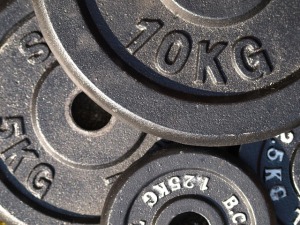
5. Not being focused on the scale but progress in the gym (faster run times, bigger lifts, accomplishing or working on certain bodyweight exercises) also helped me. It’s a mindset shift but once I managed to believe in it, I think the aesthetics are coming more naturally and with less stress.
6. Speaking of the scale, only pay attention to what it has to say IF you are also taking pictures, taking measurements, and using clothes to measure progress. By itself it is a glorified paperweight.
7. Working on controlling stress, or rather my reaction to it, has helped immensely.
8. Did I mention lifting weights? Heavy weights?
 Having said that, I’m still a work in process. And I always will be, and not because I’m broken but because I will continue to grow. So far I’ve worked hard to free myself from The Beet and Ice Cream Diet mentality, and it feels good. I don’t have all the answers and many times need to take my own advice. I know me enough to know this will probably continue. I also know me enough to know that I will stumble. I will have setbacks. And I will have victories. I’m going to do my best to keep my head and know that I will sometimes need someone to knock some sense into me. And all of that is ok. Because there are 2 days a year you can’t control – yesterday and tomorrow. That leaves today, and today, I’m just going to do my best and try to have fun doing it.
Having said that, I’m still a work in process. And I always will be, and not because I’m broken but because I will continue to grow. So far I’ve worked hard to free myself from The Beet and Ice Cream Diet mentality, and it feels good. I don’t have all the answers and many times need to take my own advice. I know me enough to know this will probably continue. I also know me enough to know that I will stumble. I will have setbacks. And I will have victories. I’m going to do my best to keep my head and know that I will sometimes need someone to knock some sense into me. And all of that is ok. Because there are 2 days a year you can’t control – yesterday and tomorrow. That leaves today, and today, I’m just going to do my best and try to have fun doing it.
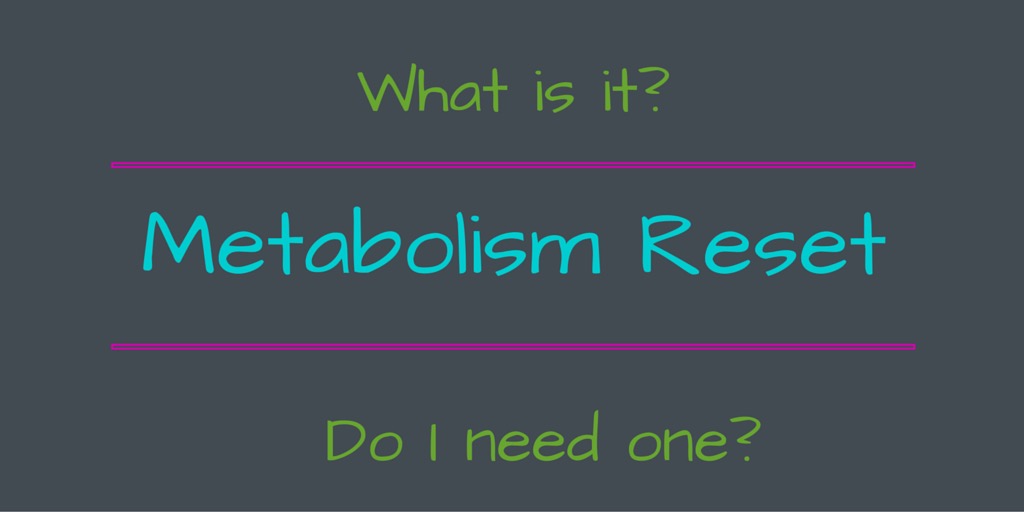
by EM2WL | Apr 21, 2015 | Increasing calories, Metabolism Reset, TDEE/BMR
Do I Need A Metabolic Reset?
If you are new to this concept of “eating more” and fueling your body properly, you undoubtedly have a lot of questions. You know you should eat  more, but how much? What is a metabolic reset? (And, do I need it?) How long will a reset take? Will this work for me, or am I that “special snowflake” that won’t have success with this? And then thoughts like “I got fat eating more. Why would I want to do that to lose weight?” start running through your mind. It’s enough to make you want to run for the hills!
more, but how much? What is a metabolic reset? (And, do I need it?) How long will a reset take? Will this work for me, or am I that “special snowflake” that won’t have success with this? And then thoughts like “I got fat eating more. Why would I want to do that to lose weight?” start running through your mind. It’s enough to make you want to run for the hills!
Just the idea of increasing calories is a terrifying thought for most people, especially when you have had the “eat less/move more” mentality drilled into your head for your whole life. We get it! We were all there once. Brainwashed by commercials with promises to get you into that skimpy bikini (or Speedo) by summer… The truth of the matter is that these diets will work for a little while, but then the end result is that your weight loss will stall as your metabolism gradually slows down to match the intake. This is the point when most of us start doing some research and realize we have been under-feeding our bodies and need to reverse the tides…
After deciding to take the plunge into the world of Eat More 2 Weigh Less, one of the first questions many people have is: “Do I need to do a metabolic reset?” Well, the answer to this question is as individual as the person asking it.
 ○ Those with a recent history of eating consistently over their TDEE should be able to calculate their TDEE, jump right in at a 15% cut, set their macros at 40/30/30 (40% Carbs, 30% Protein, 30% Fat), and begin the process fairly quickly. These people have been over-eating and have most likely not compromised or slowed their metabolisms in any way, so their bodies should respond quite well to a small deficit. This is the easiest case scenario… No metabolic reset necessary, as they have essentially already done it by previously over-eating!
○ Those with a recent history of eating consistently over their TDEE should be able to calculate their TDEE, jump right in at a 15% cut, set their macros at 40/30/30 (40% Carbs, 30% Protein, 30% Fat), and begin the process fairly quickly. These people have been over-eating and have most likely not compromised or slowed their metabolisms in any way, so their bodies should respond quite well to a small deficit. This is the easiest case scenario… No metabolic reset necessary, as they have essentially already done it by previously over-eating!
○ However… Those who come from long term low calorie dieting, binge/restrict cycles, eating disorders…etc. will have a very different process to go through as their bodies and brains adapt and finally accept the increased caloric intake. Often, years of severe caloric restriction will have resulted in a suppressed metabolism … one which has slowed down to match the decreased intake. When we consistently eat at a caloric deficit, the body will naturally assume that this deficit is now maintenance and downshift the metabolism to meet this demand. If this is your case, a reset is highly recommended.
Potentially, you could go right to that 15% cut in hopes that you would see results, but most likely, you will just be prolonging the process. You see, as you slowly increase your calories to that 15% cut, your body will simply adapt and reset at this 15% cut level, seeing that as the new “normal”. You will have, in fact, reset to your cut value, and therefore, the body will not see it as a cut. From that point, the only real option is to do a true reset, where you eat at TDEE or Maintenance calorie levels for a prolonged period of time (more about this later…) And THEN, once the body has accepted your intake at TDEE as normal, when you introduce that small 15% deficit, the body should react positively by shedding some fat.
SO, if you have been dieting for a prolonged period of time, suffered from an eating disorder or even cycles of binging followed by severe caloric restriction, do yourself a favor and work your intake slowly up to TDEE and take the time to do a metabolic reset. This process will give your body a break from the stress of dieting and allow it to become accustomed to eating proper amounts of food again. If you don’t do it at the onset, most likely you will be doubling back and doing it somewhere further down the road when you don’t see the results you were hoping to see. Skip this vital step, and you will most likely be prolonging the length of your journey rather than speeding it up.
How to Find Your “True” TDEE
So… you have decided that you need to do a metabolic reset in order to get your metabolism back up and running where it should be. Now what?
The first thing that you need to in order to start this process is to determine your TDEE (Total Daily Energy Expenditure). Your TDEE is the amount of calories that your body requires to maintain your weight. That (TDEE) figure includes your BMR (Basal Metabolic Rate) as well as your normal day-to-day activities plus any formal exercise. In theory — based on this definition — if we eat at our TDEE, we will maintain our weight. The problem is that this theory does not always hold true. When we have been under-eating and over-exercising, our body will adapt to this stress. In an attempt to maintain homeostasis, it will down-regulate the metabolism to match the decreased intake. The result will often be a suppressed metabolism. This explains why suddenly you may find yourself gaining weight while doing hours of cardio and eating 1,200 calories or less a day … your body has adapted! You have decreased your intake and increased your exercise for a long enough period of time that the body has finally slowed down your metabolism to match the intake. Your body is doing what it is supposed to do = maintain homeostasis.
To get your metabolism back up and running where it should be, you’ll need to increase your caloric intake back up to TDEE, or do a Metabolic Reset. To begin this process, the first thing you will want to do is enter your stats into the EM2WL weight loss calculator to get your TDEE (maintenance) calories. This will give you an idea of what your ultimate goal will be. But remember that these calculators just give you estimates. They are subject to error based on how much exercise you input into the calculator and how active you truly are. Many newbies to EM2WL lead very active lives, and may actually burn a lot more through their day-to-day activities. If they simply enter in the 4 hours of formal exercise that they do each week, their final TDEE estimate may actually be too low.
Alternatively, you can use an on-body device such as a FitBit, or Apple Watch to get an idea of how much you burn each day. These are likely 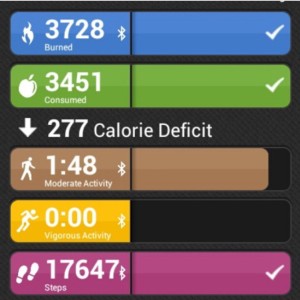 more accurate than the calculators, just because they’re monitoring how much activity you actually do each and every day. However, these devices are also not 100% accurate because they don’t accurately calculate calories burned from your strength training workouts.
more accurate than the calculators, just because they’re monitoring how much activity you actually do each and every day. However, these devices are also not 100% accurate because they don’t accurately calculate calories burned from your strength training workouts.
So, where does this leave you? How do you figure out your “true” TDEE? You have your TDEE estimate and/or your “on-body device” average, but ideally you will also test out these numbers and make sure they are truly accurate for you.
The normal process for doing a Metabolic Reset involves increasing your caloric intake up to your calculated TDEE and staying at that level for a minimum of 8 – 12 weeks (much longer if you come from a history of severe dieting or caloric restriction). We generally recommend that you make this increase slowly, adding approximately 50-100 calories to your daily intake each week. Of course, you can certainly jump right up to TDEE quickly (“rip the band-aid”) or make those increases more substantial, but you may find the increases on the scale to be discouraging. By making the increases more gradually, you can often avoid some of the gains seen during the “rip the bandaid” approach. We leave this to the individual as a personal decision.
Now, back to the original question … “How Do I Find My True TDEE?” In order to do this, you will most likely need to go through a trial and error process. You have your calculated TDEE, but how do you figure out if that is “true” or not? As you are going through the process, gradually increasing your daily caloric intake 100 calories a week, keep an eye on the scale. Generally, as you make these increases, you may see the scale jump up a pound or two, and then during the course of the week, it will generally trend back downwards, often ending up right back where you started, pre-increase. As you get closer and closer to your calculated TDEE, you may find that it takes a bit longer for your weight to stabilize and drop back down. At this point, if you find that happening, you may want to take it a bit slower. Then if your weight has not stabilized and dropped back down by the end of the week, wait until it does before making any further increases.
Once you are at or near your calculated TDEE, watch for slow and steady increases on the scale which do not stabilize over time. If you do start seeing gains like this, you have most likely surpassed your TDEE, and which point you can back down on your intake by 100 calories or so and you should be right there — at your true TDEE.
What many people find is that their actual TDEE may be higher than what they get with the calculators. Often their day-to-day activities (chasing kids, doing laundry…etc.) makes them more active than the activity level that they chose when inputting their data into a calculator. We often tend to underestimate how active we are. Many people find that they are actually able to eat 100 or 200 calories more than the calculators give them, simply by “testing the waters” and not blindly accepting those numbers as accurate.
So, give it a try! Surely by now, you have resigned yourself to the fact that this is not a fast process, so take the time to make sure you know your “true TDEE.” Don’t blindly trust the calculators, test it out and see how much you can really eat before you start seeing true gains. Ignore those monthly fluctuations and the jumps that occur after increasing your intake. Keep pushing your intake higher and higher until you start to see slow, steady gains that do not stabilize over time. As hard as it may be, don’t worry about gaining. You can always just drop your intake down and those gains will stop. Remember: nothing that you are doing during this process is irreversible. Take the time to do it right … right from the beginning. You won’t regret it!
When Does My Reset Start?
You have finally gotten brave and decided to do a metabolic reset. You have diligently upped your intake slowly to your calculated TDEE level.

You added 100 calories on each week, and faithfully continued this process until you got your intake from rock bottom all the way up to your maintenance calories, maybe taking months to get to this point. Yay! Now you have reached TDEE, and you are ready to cut, right? NO. Now, this is the point where your metabolic reset actually begins. This is the point where the healing of body and mind starts to take place as your body begins to trust that this new, increased intake will be consistent, and not just another fluctuation, like so many times in the past. Yes, you have just spent what is possibly a few months getting your intake up to maintenance levels, but technically, your reset has not yet begun until now.
Now, you will need to stay eating consistently at TDEE levels for a minimum of 8 – 12 weeks, possibly longer if you come from a long history of severe caloric restriction. Some people have found it takes as long as a year to become fully healed and ready to move on. This part of the journey is as individual as the person taking it. Everybody is different and one size certainly does not fit all. Use this time to introduce strength training into your life, if you haven’t already done so, and enjoy the benefits of building some muscle (which really is possible now that you are finally eating at TDEE). Sit back and truly learn to love eating more.
When Is My Reset Over?
Okay, so you didn’t rush the metabolism reset. You have eaten diligently at maintenance levels for two, three, eight, maybe even twelve months. Congratulations! Now, how do you know when it is over? How do you know when it is the right time to cut?
There are a few key things to look at when making that decision:
○ One thing to consider is the mental aspect of the journey. For many, it is just as important as the physical part. Hopefully, during your reset you have changed the way you view your food. Food is no longer the enemy, and you have begun to see and appreciate it as a much-needed source of fuel. You have learned to no longer fear carbs or fats, and instead fit them in to your daily life (yes, even chocolate!). We feature a lot of Success Stories from EM2WL followers on our website, and hopefully when you read them you have noticed the mental transitions that had to take place both before and during the reset process. This is a vital part of the process. If you have not fully embraced eating more, then you are not ready for a cut.
○ Are you rushing to finish your reset? Are you in a hurry to start that cut? Are you counting down the days until you can introduce that 15% deficit and begin your weight loss journey? If this is you, then you are most likely not ready. At least not mentally…. When your reset is over, you will know it. You will have fully accepted that this is your new way of life. In fact, when you are ready, you will actually be dreading the day you have to give up any calories! Suddenly that 15% deficit will seem huge and you will be contemplating starting with just a 10% cut, or maybe even 8%, or 5… You get the idea :-)
○ As far as the physical aspect, if you have been eating at an extreme deficit prior to beginning your reset and had symptoms of metabolic damage such as fatigue, hair loss, brittle nails, low body temperature and/or loss of menstruation, you should begin to see all of these improving. Seeing improvements in these areas is a good sign that your body is recovering and now using those additional calories for normal maintenance functions, and not simply the vital ones.
 ○ Your weight will have stabilized. Often, the reset process comes with some associated weight gain. Some of that is water, as glycogen stores are refilled. Some of it may come from other sources. When we subject our bodies to severe caloric restriction and excessive cardio, the weight that is lost is not all necessarily fat. The weight that is lost can also be from muscles, tendons, ligaments and even brain tissue! As we begin to re-feed and nourish our bodies properly, the body will begin to rebuild that muscle, tendon, ligament and brain tissue and that will show up as a gain on the scale. Note: this is just another reason to not rely on the scale as your sole method for gauging success. Not all scale losses are good ones! … I mean, who wants to lose brain tissue?!
○ Your weight will have stabilized. Often, the reset process comes with some associated weight gain. Some of that is water, as glycogen stores are refilled. Some of it may come from other sources. When we subject our bodies to severe caloric restriction and excessive cardio, the weight that is lost is not all necessarily fat. The weight that is lost can also be from muscles, tendons, ligaments and even brain tissue! As we begin to re-feed and nourish our bodies properly, the body will begin to rebuild that muscle, tendon, ligament and brain tissue and that will show up as a gain on the scale. Note: this is just another reason to not rely on the scale as your sole method for gauging success. Not all scale losses are good ones! … I mean, who wants to lose brain tissue?!
As you have worked your way through the reset process, chances are, your weight may have fluctuated. A lot. By the time your reset is complete, these fluctuations should have stabilized. Yes, you will still have those ups and downs caused by water retention following a high sodium day, or water retention due to DOMS following a heavy lifting day, or that normal 3 – 5 pound gain many see around TOM, but overall your weight should be holding fairly stable.
○ By the time you are ready to cut, all of those overly full, bloated feelings that you may have experienced as you increased your calories should have subsided. You should feel comfortable eating at your Maintenance calories (TDEE). You should not feel like an over-stuffed turkey on Thanksgiving, in fact you should feel hungry again! These are all signs that your metabolism has returned to a normal state.
No matter what your dieting history, EM2WL will work for you. It is all just a matter of doing your research, figuring out your “numbers” and determining what plan will be correct for you, and then putting that plan in place to get you to your caloric goal. Each person’s plans will be different. Some people will see results in as little as 4 – 6 weeks, while others may take as long as a year, depending on their dieting history (the more severe the dieting history, the longer the “metabolic healing” can be expected to take). Research and patience will be key, in either case. And, if you need help along the way, EM2WL is here to help with our online courses and coaching programs.

 I’ve followed the EM2WL method for a few years (with great success!), and then last autumn, race season got a little crazy because I signed up for 2 half marathons. I enjoy running for the sanity-saving benefits (I have 4 kids ages 3-6!) but I LOVE lifting because I love being strong! Since I promised some friends I would run in the half-marathons, though, lifting had to take a backseat while I trained for those races. I was eating “enough” but noticing fat gain/muscle loss and started reducing my calories to try to tweak things. Obviously that was not the thing to do, as my body composition started getting worse and worse, despite eating fewer calories. I never NETTED below 1700 but with how much running I was doing, I still needed more, plus I needed to add lifting back in. (I wish I could go back in time to August 2015 when I started the crazy lowering-lowering-lowering of calories to tell myself to start increasing instead!! But lesson learned.)
I’ve followed the EM2WL method for a few years (with great success!), and then last autumn, race season got a little crazy because I signed up for 2 half marathons. I enjoy running for the sanity-saving benefits (I have 4 kids ages 3-6!) but I LOVE lifting because I love being strong! Since I promised some friends I would run in the half-marathons, though, lifting had to take a backseat while I trained for those races. I was eating “enough” but noticing fat gain/muscle loss and started reducing my calories to try to tweak things. Obviously that was not the thing to do, as my body composition started getting worse and worse, despite eating fewer calories. I never NETTED below 1700 but with how much running I was doing, I still needed more, plus I needed to add lifting back in. (I wish I could go back in time to August 2015 when I started the crazy lowering-lowering-lowering of calories to tell myself to start increasing instead!! But lesson learned.) BEST. DECISION. EVER.
BEST. DECISION. EVER.



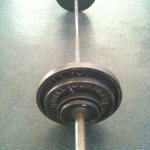


























Recent Comments